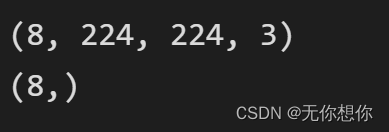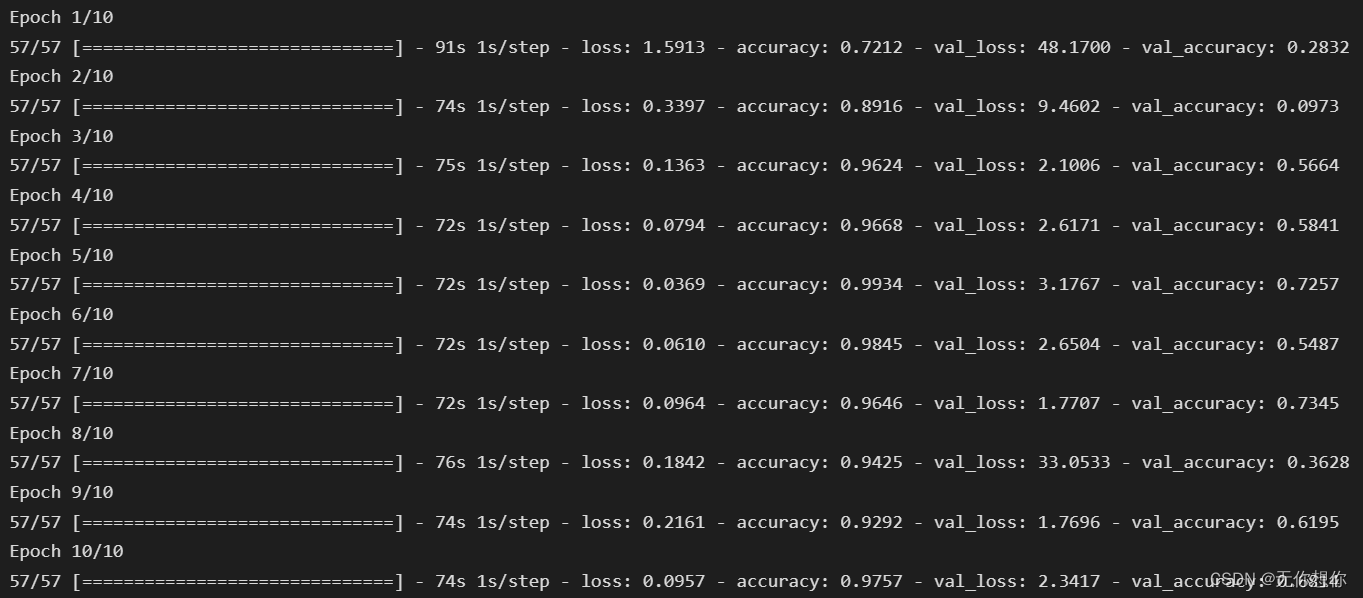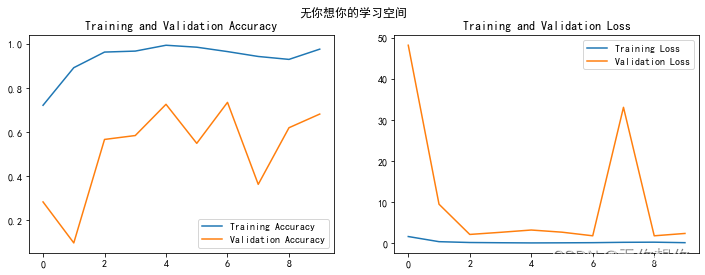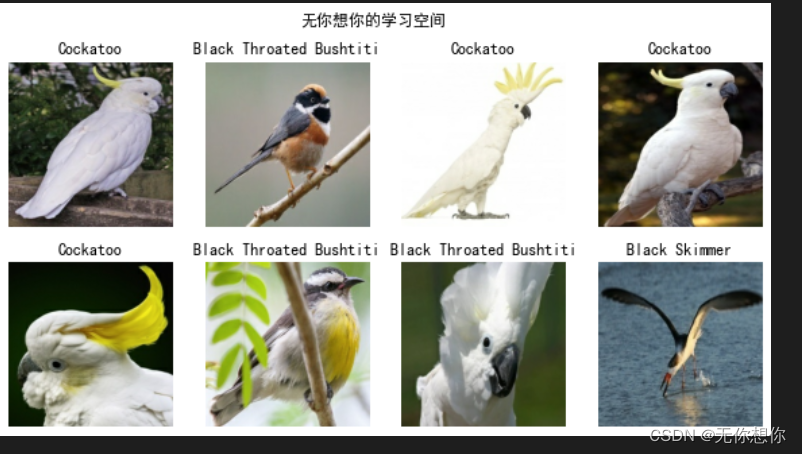原文链接
- 🍨 本文为🔗365天深度学习训练营 中的学习记录博客
- 🍦 参考文章:365天深度学习训练营-第P8周:实现鸟类识别
- 🍖 原作者:K同学啊|接辅导、项目定制
环境介绍
- 语言环境:Python3.9.13
- 编译器:jupyter notebook
- 深度学习环境:TensorFlow2
前置工作
设置GPU
使用gpu可以加快运行速度
#设置gpu
import tensorflow as tf
gpus = tf.config.list_physical_devices("GPU")
if gpus:
tf.config.experimental.set_memory_growth(gpus[0], True) #设置GPU显存用量按需使用
tf.config.set_visible_devices([gpus[0]],"GPU")
导入数据并进行查找
# 导入数据
import matplotlib.pyplot as plt
# 支持中文
plt.rcParams['font.sans-serif'] = ['SimHei'] # 用来正常显示中文标签
plt.rcParams['axes.unicode_minus'] = False # 用来正常显示负号
import os,PIL
# 设置随机种子尽可能使结果可以重现
import numpy as np
np.random.seed(1)
# 设置随机种子尽可能使结果可以重现
import tensorflow as tf
tf.random.set_seed(1)
from tensorflow import keras
from tensorflow.keras import layers,models
import pathlib
查看数据
data_dir = "D:/BaiduNetdiskDownload/第8天-没有加密版本/第8天/bird_photos"
data_dir = pathlib.Path(data_dir)
#3. 查看数据
image_count = len(list(data_dir.glob('*/*')))
print("图片总数为:",image_count)
我们可以知道一共有565张照片
数据处理
| 文件夹 | 数量 |
|---|---|
| Bananaquit | 166 张 |
| Black Throated Bushtiti | 111 张 |
| Black skimmer | 122 张 |
| Cockatoo | 166张 |
对数据进行加载操作
使用image_dataset_from_directory方法将磁盘中的数据加载到tf.data.Dataset中
batch_size = 8
img_height = 224
img_width = 224
"""
关于image_dataset_from_directory()的详细介绍可以参考文章:https://mtyjkh.blog.csdn.net/article/details/117018789
"""
train_ds = tf.keras.preprocessing.image_dataset_from_directory(
data_dir,
validation_split=0.2,
subset="training",
seed=123,
image_size=(img_height, img_width),
batch_size=batch_size)
#使用当中的452张进行训练
使用当中的452张进行训练
"""
关于image_dataset_from_directory()的详细介绍可以参考文章:https://mtyjkh.blog.csdn.net/article/details/117018789
"""
val_ds = tf.keras.preprocessing.image_dataset_from_directory(
data_dir,
validation_split=0.2,
subset="validation",
seed=123,
image_size=(img_height, img_width),
batch_size=batch_size)
使用113张进行预测操作
# 使用class_name输出数据集的标签
class_names = train_ds.class_names
print(class_names)

可视化数据
plt.figure(figsize=(10, 5)) # 图形的宽为10高为5
plt.suptitle("无你想你的学习训练")
for images, labels in train_ds.take(1):
for i in range(8):
ax = plt.subplot(2, 4, i + 1)
plt.imshow(images[i].numpy().astype("uint8"))
plt.title(class_names[labels[i]])
plt.axis("off")

plt.imshow(images[4].numpy().astype("uint8"))

再次对数据进行检查
for image_batch, labels_batch in train_ds:
print(image_batch.shape)
print(labels_batch.shape)
break

- Image_batch是形状的张量(8, 224, 224, 3)。这是一批形状240x240x3的8张图片(最后一维指的是彩色通道RGB)。
- Label_batch是形状(8,)的张量,这些标签对应8张图片
配置数据集
- shuffle() :打乱数据,关于此函数的详细介绍可以参考:https://zhuanlan.zhihu.com/p/42417456
- prefetch() :预取数据,加速运行,其详细介绍可以参考我前两篇文章,里面都有讲解。
- cache() :将数据集缓存到内存当中,加速运行
AUTOTUNE = tf.data.AUTOTUNE
train_ds = train_ds.cache().shuffle(1000).prefetch(buffer_size=AUTOTUNE)
val_ds = val_ds.cache().prefetch(buffer_size=AUTOTUNE)
残差网络的介绍
残差网络是为了解决神经网络隐藏层过多时,而引起的网络退化问题。退化(degradation)问题是指:当网络隐藏层变多时,网络的准确度达到饱和然后急剧退化,而且这个退化不是由于过拟合引起的。
构建残差网络
from keras import layers
from keras.layers import Input,Activation,BatchNormalization,Flatten
from keras.layers import Dense,Conv2D,MaxPooling2D,ZeroPadding2D,AveragePooling2D
from keras.models import Model
def identity_block(input_tensor, kernel_size, filters, stage, block):
filters1, filters2, filters3 = filters
name_base = str(stage) + block + '_identity_block_'
x = Conv2D(filters1, (1, 1), name=name_base + 'conv1')(input_tensor)
x = BatchNormalization(name=name_base + 'bn1')(x)
x = Activation('relu', name=name_base + 'relu1')(x)
x = Conv2D(filters2, kernel_size,padding='same', name=name_base + 'conv2')(x)
x = BatchNormalization(name=name_base + 'bn2')(x)
x = Activation('relu', name=name_base + 'relu2')(x)
x = Conv2D(filters3, (1, 1), name=name_base + 'conv3')(x)
x = BatchNormalization(name=name_base + 'bn3')(x)
x = layers.add([x, input_tensor] ,name=name_base + 'add')
x = Activation('relu', name=name_base + 'relu4')(x)
return x
def conv_block(input_tensor, kernel_size, filters, stage, block, strides=(2, 2)):
filters1, filters2, filters3 = filters
res_name_base = str(stage) + block + '_conv_block_res_'
name_base = str(stage) + block + '_conv_block_'
x = Conv2D(filters1, (1, 1), strides=strides, name=name_base + 'conv1')(input_tensor)
x = BatchNormalization(name=name_base + 'bn1')(x)
x = Activation('relu', name=name_base + 'relu1')(x)
x = Conv2D(filters2, kernel_size, padding='same', name=name_base + 'conv2')(x)
x = BatchNormalization(name=name_base + 'bn2')(x)
x = Activation('relu', name=name_base + 'relu2')(x)
x = Conv2D(filters3, (1, 1), name=name_base + 'conv3')(x)
x = BatchNormalization(name=name_base + 'bn3')(x)
shortcut = Conv2D(filters3, (1, 1), strides=strides, name=res_name_base + 'conv')(input_tensor)
shortcut = BatchNormalization(name=res_name_base + 'bn')(shortcut)
x = layers.add([x, shortcut], name=name_base+'add')
x = Activation('relu', name=name_base+'relu4')(x)
return x
def ResNet50(input_shape=[224,224,3],classes=1000):
img_input = Input(shape=input_shape)
x = ZeroPadding2D((3, 3))(img_input)
x = Conv2D(64, (7, 7), strides=(2, 2), name='conv1')(x)
x = BatchNormalization(name='bn_conv1')(x)
x = Activation('relu')(x)
x = MaxPooling2D((3, 3), strides=(2, 2))(x)
x = conv_block(x, 3, [64, 64, 256], stage=2, block='a', strides=(1, 1))
x = identity_block(x, 3, [64, 64, 256], stage=2, block='b')
x = identity_block(x, 3, [64, 64, 256], stage=2, block='c')
x = conv_block(x, 3, [128, 128, 512], stage=3, block='a')
x = identity_block(x, 3, [128, 128, 512], stage=3, block='b')
x = identity_block(x, 3, [128, 128, 512], stage=3, block='c')
x = identity_block(x, 3, [128, 128, 512], stage=3, block='d')
x = conv_block(x, 3, [256, 256, 1024], stage=4, block='a')
x = identity_block(x, 3, [256, 256, 1024], stage=4, block='b')
x = identity_block(x, 3, [256, 256, 1024], stage=4, block='c')
x = identity_block(x, 3, [256, 256, 1024], stage=4, block='d')
x = identity_block(x, 3, [256, 256, 1024], stage=4, block='e')
x = identity_block(x, 3, [256, 256, 1024], stage=4, block='f')
x = conv_block(x, 3, [512, 512, 2048], stage=5, block='a')
x = identity_block(x, 3, [512, 512, 2048], stage=5, block='b')
x = identity_block(x, 3, [512, 512, 2048], stage=5, block='c')
x = AveragePooling2D((7, 7), name='avg_pool')(x)
x = Flatten()(x)
x = Dense(classes, activation='softmax', name='fc1000')(x)
model = Model(img_input, x, name='resnet50')
# 加载预训练模型
model.load_weights("resnet50_weights_tf_dim_ordering_tf_kernels.h5")
return model
model = ResNet50()
model.summary()

模型训练
开始编译
- 损失函数(loss):用于衡量模型在训练期间的准确率。
- 优化器(optimizer):决定模型如何根据其看到的数据和自身的损失函数进行更新。
- 指标(metrics):用于监控训练和测试步骤。以下示例使用了准确率,即被正确分类的图像的比率
# 设置优化器,我这里改变了学习率。
opt = tf.keras.optimizers.Adam(learning_rate=1e-7)
model.compile(optimizer="adam",
loss='sparse_categorical_crossentropy',
metrics=['accuracy'])
开始训练
epochs = 10
history = model.fit(
train_ds,
validation_data=val_ds,
epochs=epochs
)

结果可视化
训练样本和测试样本
acc = history.history['accuracy']
val_acc = history.history['val_accuracy']
loss = history.history['loss']
val_loss = history.history['val_loss']
epochs_range = range(epochs)
plt.figure(figsize=(12, 4))
plt.subplot(1, 2, 1)
plt.suptitle("无你想你的学习空间")
plt.plot(epochs_range, acc, label='Training Accuracy')
plt.plot(epochs_range, val_acc, label='Validation Accuracy')
plt.legend(loc='lower right')
plt.title('Training and Validation Accuracy')
plt.subplot(1, 2, 2)
plt.plot(epochs_range, loss, label='Training Loss')
plt.plot(epochs_range, val_loss, label='Validation Loss')
plt.legend(loc='upper right')
plt.title('Training and Validation Loss')
plt.show()

预测
# 保存模型
model.save('model/my_model.h5')
# 加载模型
new_model = keras.models.load_model('model/my_model.h5')
# 采用加载的模型(new_model)来看预测结果
plt.figure(figsize=(10, 5)) # 图形的宽为10高为5
plt.suptitle("无你想你的学习空间")
for images, labels in val_ds.take(1):
for i in range(8):
ax = plt.subplot(2, 4, i + 1)
# 显示图片
plt.imshow(images[i].numpy().astype("uint8"))
# 需要给图片增加一个维度
img_array = tf.expand_dims(images[i], 0)
# 使用模型预测图片中的人物
predictions = new_model.predict(img_array)
plt.title(class_names[np.argmax(predictions)])
plt.axis("off")






















 3713
3713











 被折叠的 条评论
为什么被折叠?
被折叠的 条评论
为什么被折叠?








